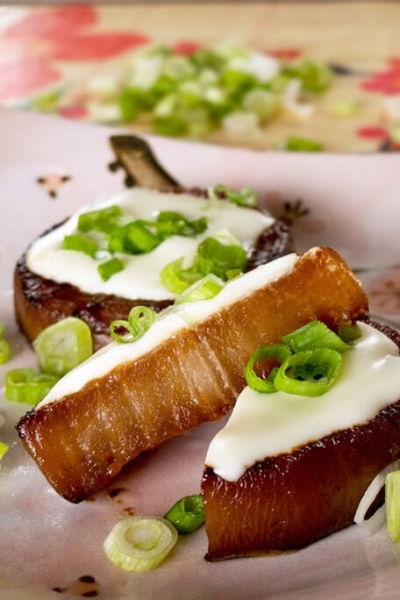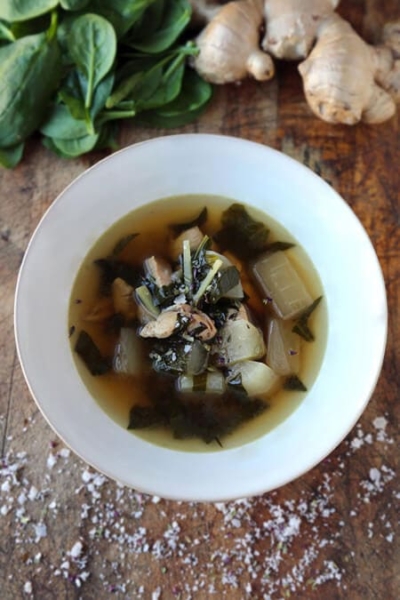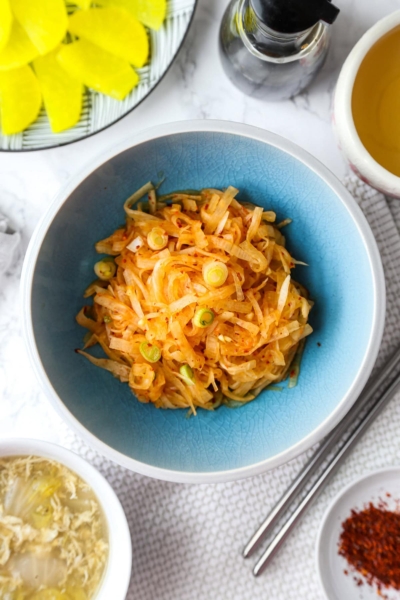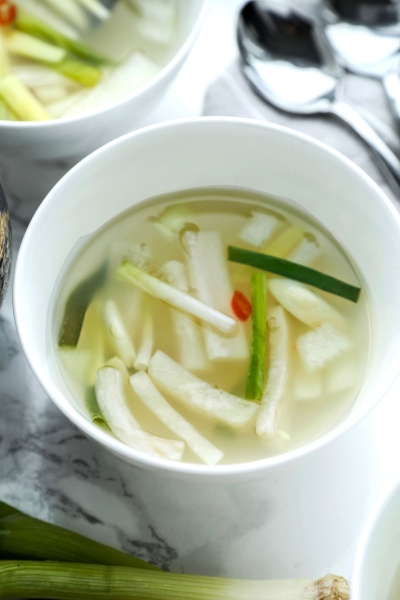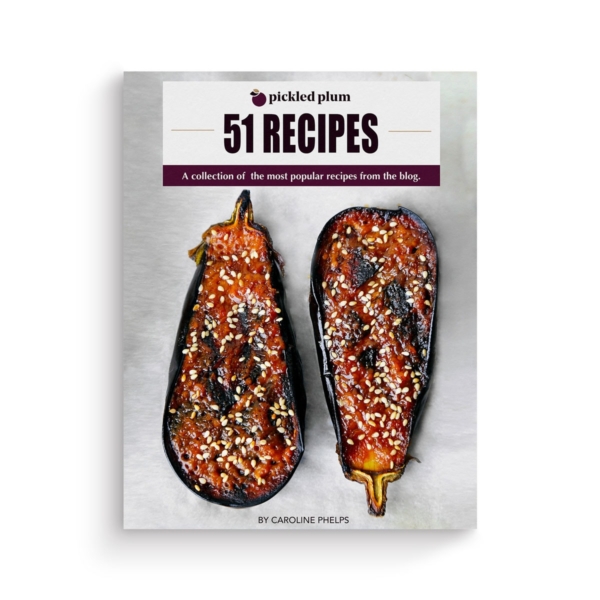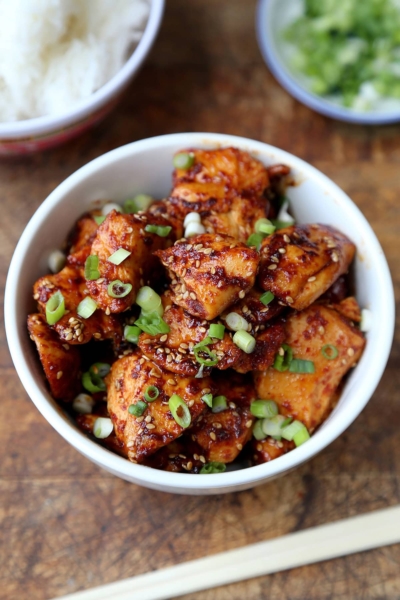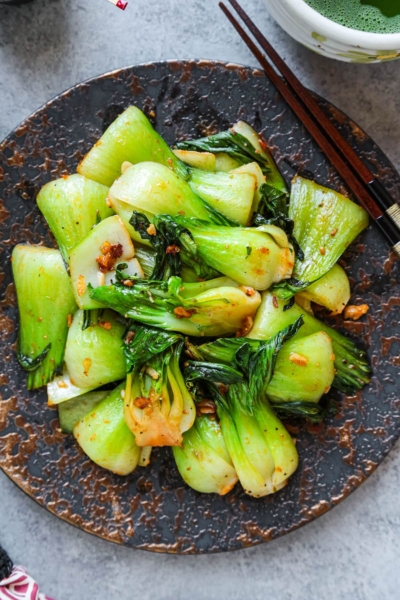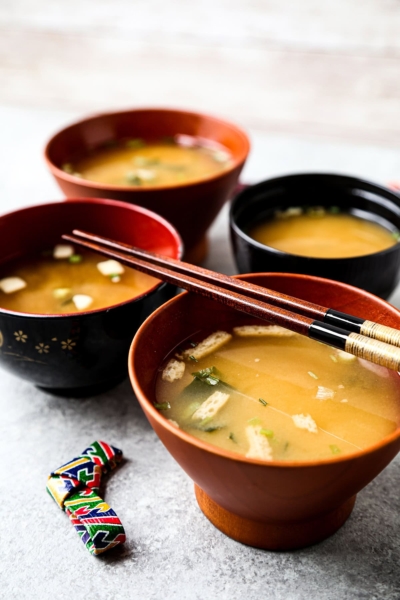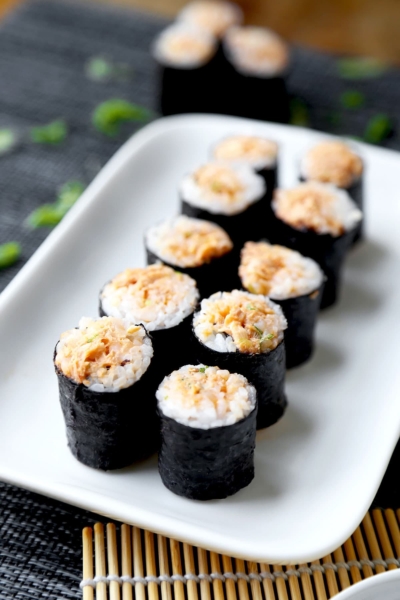This is a simple roasted daikon recipe that enhances the natural sweetness of radish. Brushed with a mixture of miso paste, garlic, and rosemary, it is the perfect side to pair with other rustic style dishes.
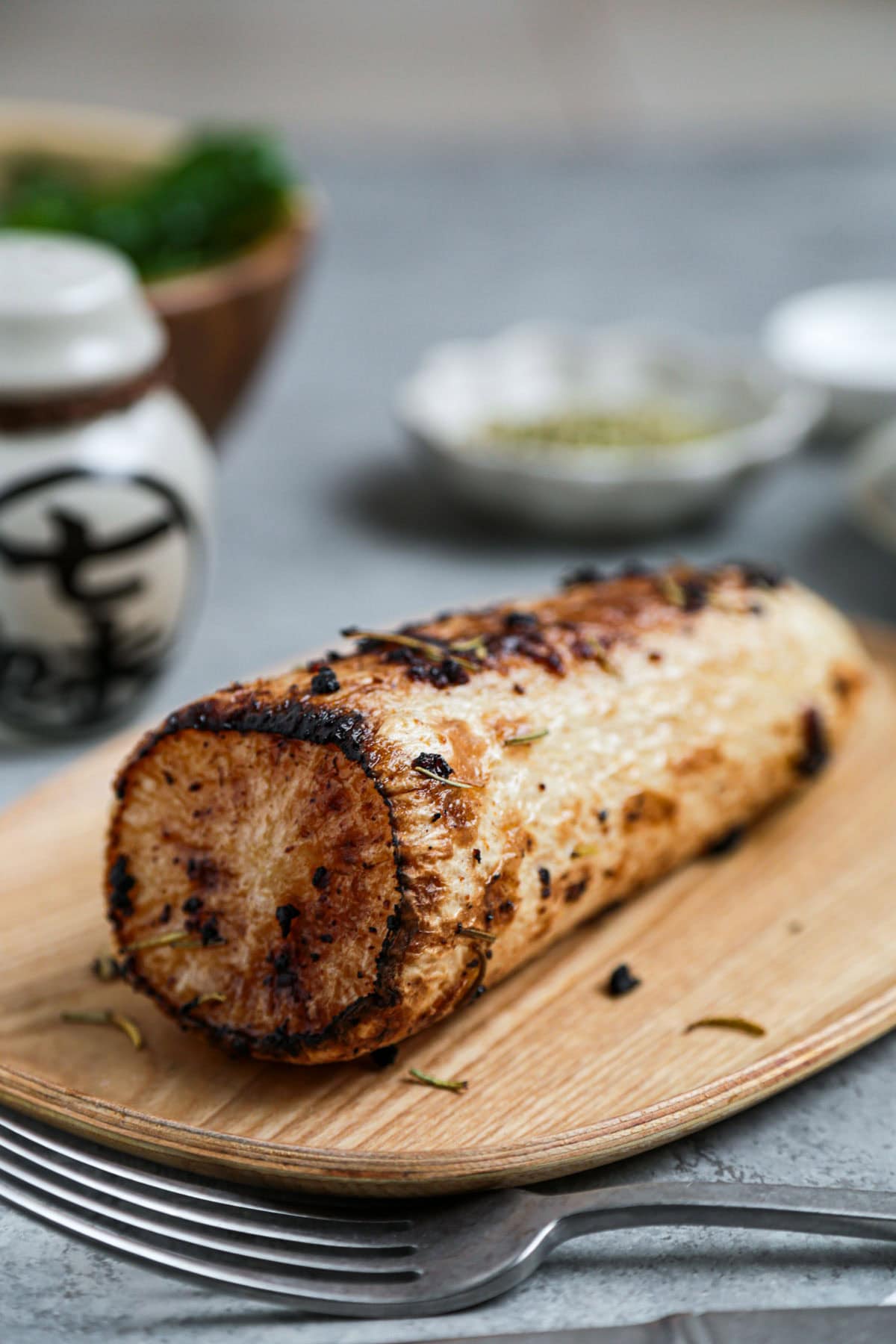
The texture of this roasted daikon is what makes this dish so great. Yes, the flavor is also delicious but the texture alone is melt-in-your-mouth hard to resist! With its slightly charred exterior and perfectly moist interior, it’s hard to stop after just a few bites. It’s sort of like a cross between a roasted cauliflower and jicama.
The recipe is very simple and easy to follow. Only 6 ingredients are needed and there is minimal prepping involved. Just brush it, roast it, and enjoy it! This roasted daikon recipe takes about 1 hour to make in the oven.
Table of contents
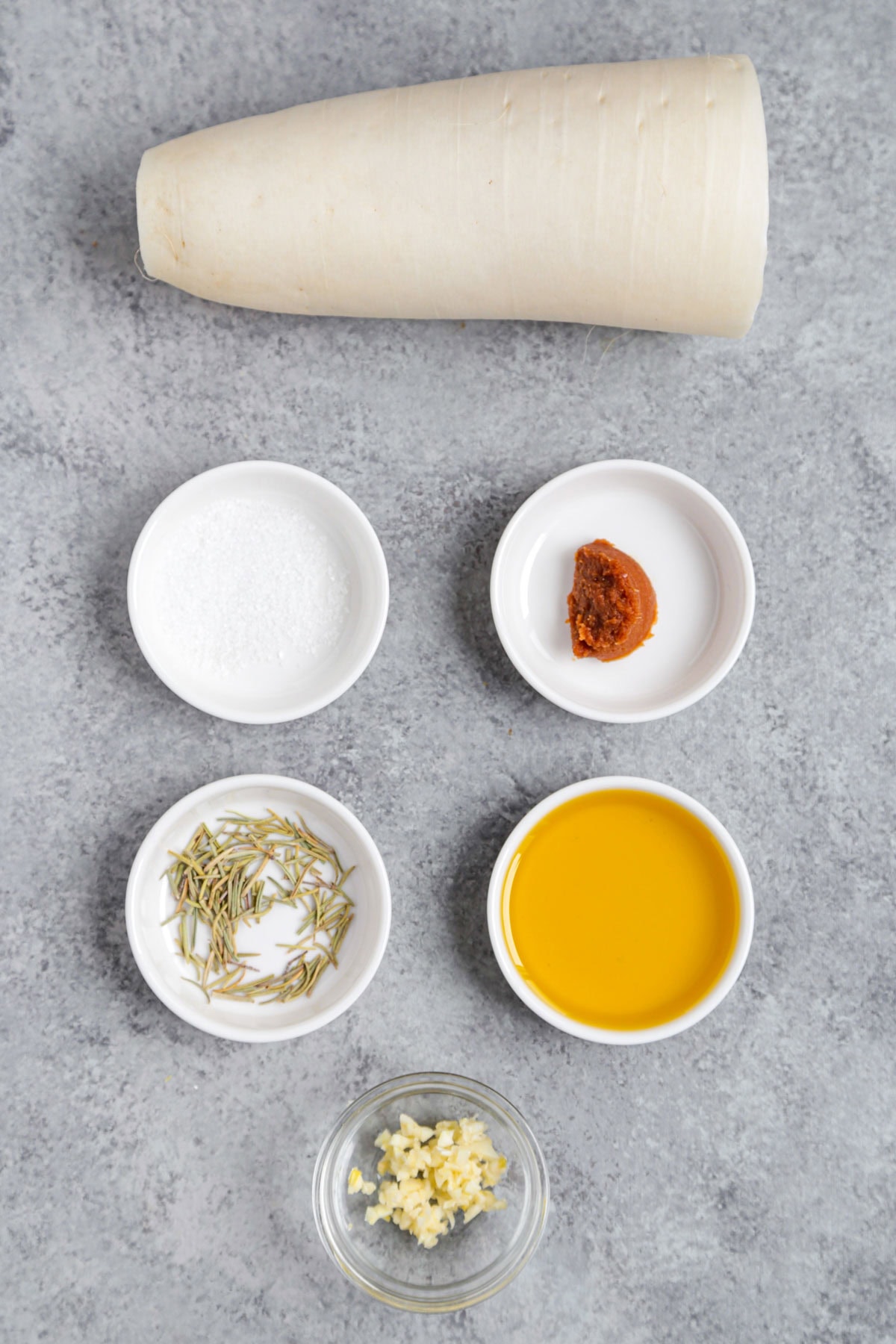
Ingredients For Miso Roasted Daikon
- Daikon: Pick a daikon that’s on the thinner and smaller side. Thin is better because it cooks faster. Scroll down to find out how to choose the best daikon.
- Olive oil: Using a regular olive oil is fine. Since the daikon is the main flavor of the dish, there is no need to use a high quality cold pressed olive oil for this recipe.
- Rosemary: Both dried or fresh rosemary work for this recipe. You will need about a sprig to add some woodsy, piney, and earthy aromatics.
- Salt: Brushing the daikon with some salt enhances its natural flavor.
- Garlic: 1 small clove of garlic, minced, infuses the dish with a little sweetness.
- Miso paste: Lastly, white miso paste! This Japanese ingredient is full of umami and adds a savory and nutty element.
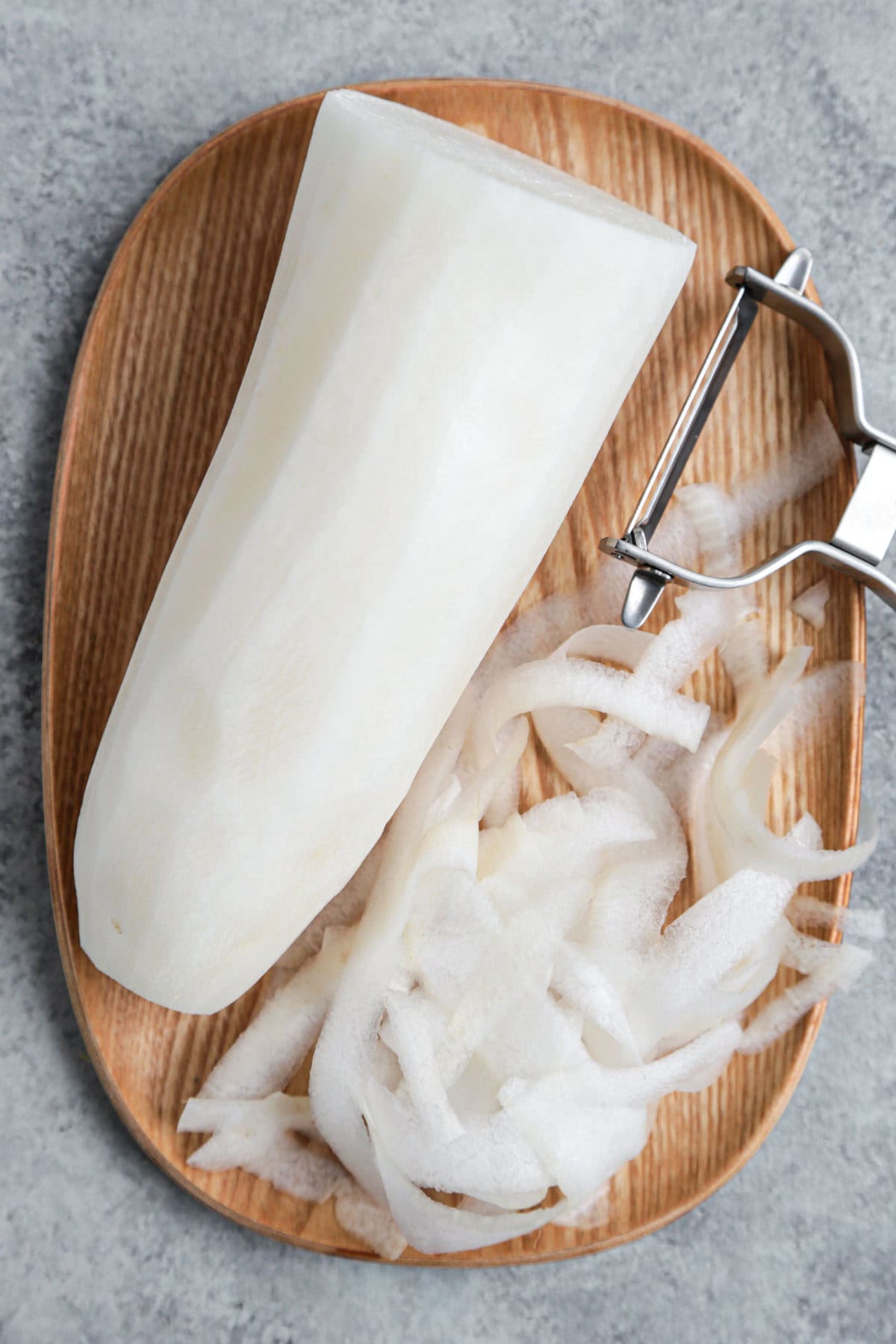
Choosing And Prepping Daikon
When cooking with daikon, it’s important to pick the right one as the success of the dish relies heavily on its quality. A good daikon should be slightly sweet, not too bitter, and moist.
To find the best daikon, pick one that’s white and heavy. The heaviness will tell you how juicy it is and the color will tell you how young it is. Stay away from ones that have a lot of green spots as they can be bitter.
Look for a smooth surface with small, clean, and even holes. Ones with dents and deeper holes can mean that they are too mature.
If the daikon has leaves, pick the one with the greenest leaves. Stay away from ones that have have new leaves sprouting from the center as it means that the daikon is mature.
How To Make Miso Roasted Daikon
Scroll down to the recipe card for the full recipe.
- Turn on the heat. Prep the baking tray by covering it with non-stick foil and preheat the oven to 400ºF.
- Clean and peel the daikon. Wash the daikon to get rid of any residues and peel it until you get to the part where the flesh is almost clear. It might be a few layers before you get to that part so be patient. Or, you can peel the skin into a long sheet using a knife, slicing by rotating the vegetable. This method is called katsuramuki, where the skin is peeled in one continuous motion.
- Season the oil by adding the rosemary, salt, garlic, and miso paste. Whisk until the miso paste has mixed with the oil.
- Season the daikon. Place the daikon on the baking tray and brush the oil on the daikon using a basting brush, turning it over to brush all sides evenly.
- Roast it. Put the daikon in the oven and roast for 15 minutes. Take the daikon out of the oven and brush it again with the flavored oil. Roast for another 15 minutes. Repeat this steps as many times as needed until the daikon is tender. Use a knife or skewer and pierce the center of the daikon. The daikon is ready when the knife or skewer goes through it easily.
- Enjoy! Season with a little more salt or a drizzle of eel sauce on top. Serve.
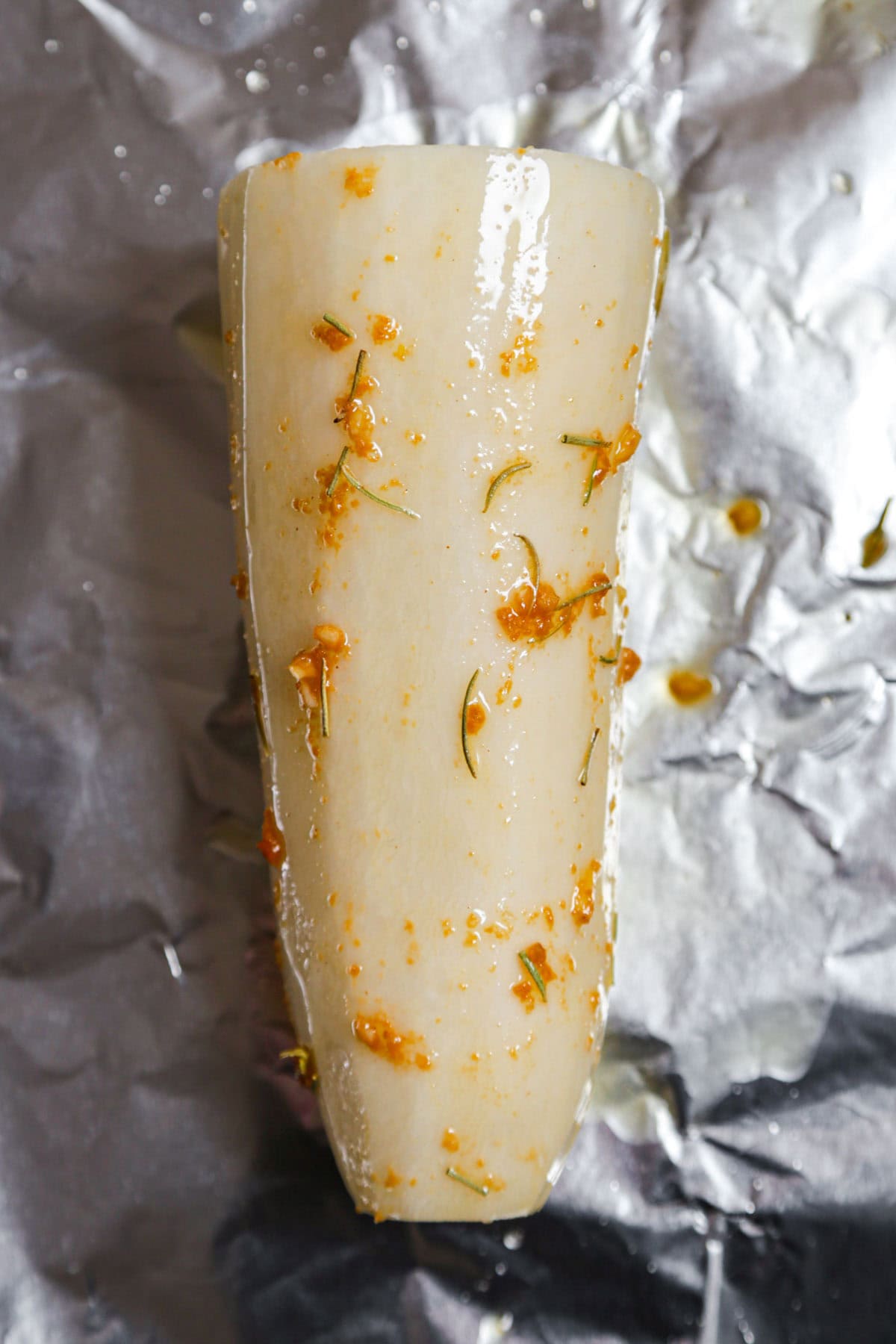
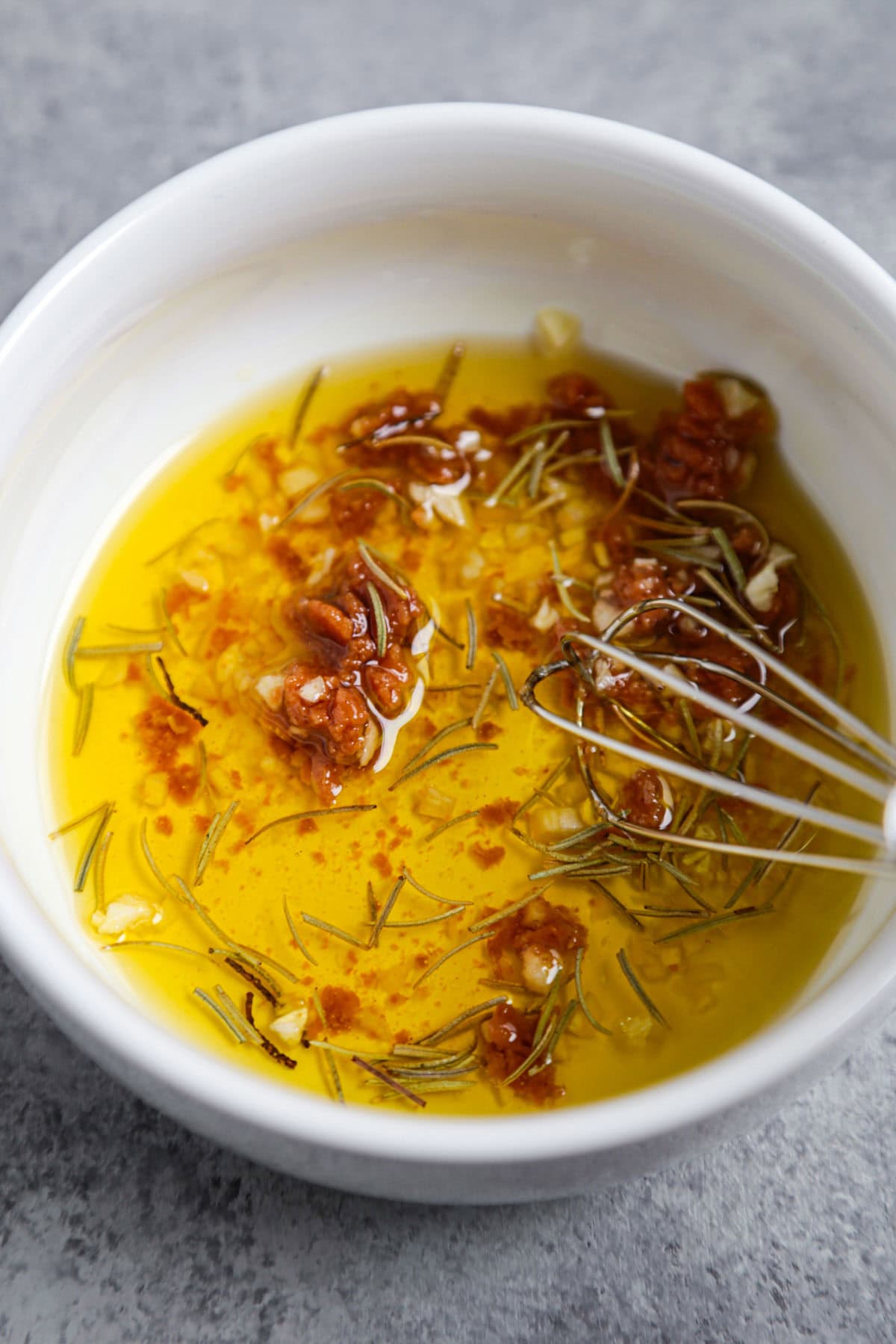
Storage And Reheating
Storage: To store leftovers, place the daikon in a storage container and close with a lid. Refrigerate for up to 4 days.
Reheating: To reheat, microwave on high for 1 to 2 minutes. Or, if you’d like to give it a crispy texture, put it in a skillet with a little oil and pan fry on medium for a few minutes. Be careful not to overcook it as the outside might char too much and turn black.
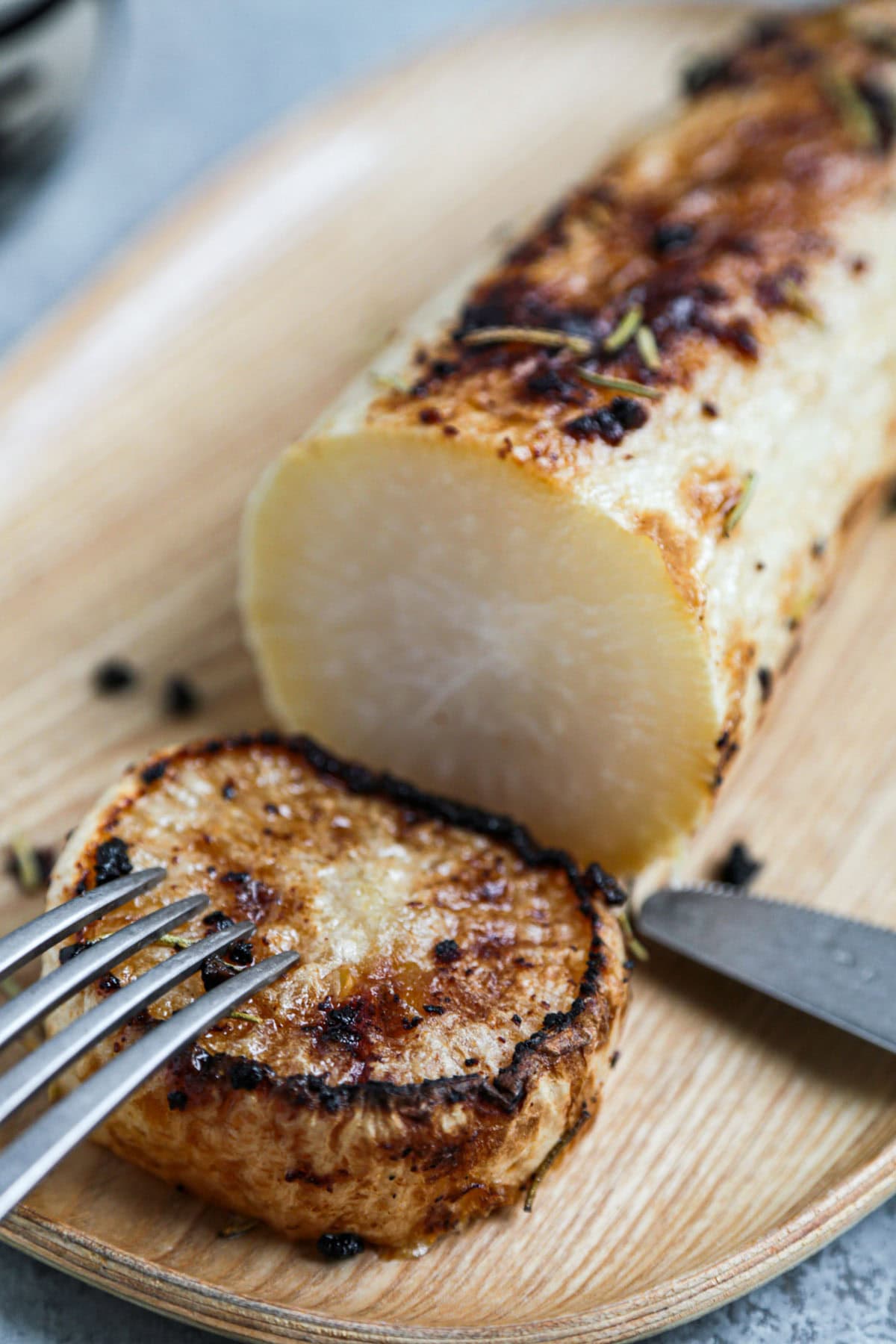
Frequently Asked Questions
Yes you can. Feel free to use other herbs such as parsley, thyme, or sage.
The daikon might be old and too dry to achieve a tender texture. The other reason could be that it’s too thick and taking a lot longer for the center to cook. If that’s the case, slice the daikon in half, widthwise. This will speed up the roasting process.
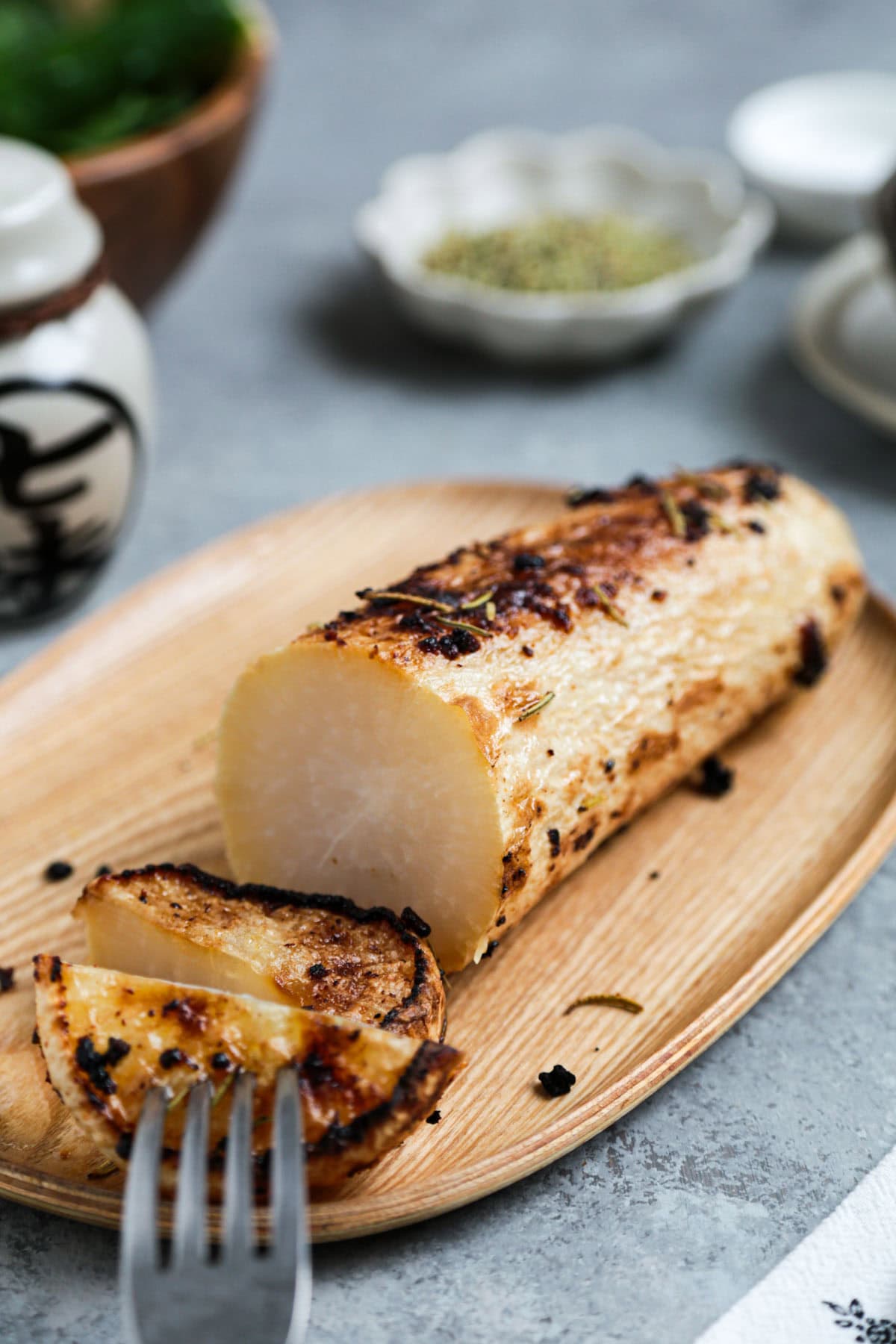
Serving Suggestions
This miso roasted daikon is best served as a side dish because it’s light and has a delicate taste. I find that it pairs nicely with other rustic style dishes such as chicken piccata, pan seared cod with balsamic sauce, salmon en papillote, slow cooker pinto beans, Spanish tomato bean stew, spaghetti bolognese, and hearty Tuscan soup.
Or, to stick to a Japanese meal try these dishes: Crispy baked chicken katsu, Japanese fried rice (yakimeshi), tofu burger patties, miso salmon, niratama donburi, Japanese pinto bean stew.
Other Recipes Using Daikon

Did you like this recipe? Are there changes you made that you would like to share? Share your tips and recommendations in the comments section below!
Print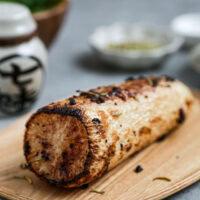
Miso Roasted Daikon
- Prep Time: 10 minutes
- Cook Time: 1 hour
- Total Time: 1 hour 10 minutes
- Yield: 2 servings 1x
- Category: Side
- Method: Oven
- Cuisine: Japanese
- Diet: Vegetarian
Ingredients
- 1 daikon radish, about 1 pound
- 3 tablespoons olive oil
- 1/2 teaspoon fresh or dried rosemary
- 1/4 teaspoon salt
- 1 small garlic clove, minced
- 1 teaspoon white miso paste mixed with 1 teaspoon water
Instructions
- Warm up the oven: Preheat the oven to 400ºF.
- Prep the tray: Cover a baking tray with non-stick foil.
- Peel the daikon: Rinse the daikon and pat dry with a paper towel. Peel it until you get to the part where the flesh is slightly transparent. Daikon skin can be pretty thick so you may have to peel a few layers before getting to the juicy and clear part. Place it on the baking tray and set aside.
- Make the flavored oil: In a small bowl, whisk the olive oil, dried rosemary, salt, garlic, and miso paste, until the mixture has combined.
- Brush the daikon: Use a basting brush and brush the daikon on all sides. Do not throw away the mixture as you will need it again a few times! Roast in the oven for 15 minutes.
- Repeat the same step a few times: Take the daikon out and brush it again. Place it back in the oven for another 15 minutes. Repeat this step 3 to 5 more times, or until the daikon is cooked through.
- Check on the doneness: Verify the doneness by sticking a knife through the daikon or using a kebab skewer. If the knife goes through it easily, the daikon is ready.
- Serve it: Place the daikon on a serving plate and season with a little salt or a drizzle of eel sauce. Serve.
Nutrition
- Serving Size: 1 serving
- Calories: 172
- Sugar: 0g
- Sodium: 307mg
- Fat: 17.8g
- Saturated Fat: 2.6g
- Unsaturated Fat: 1.9g
- Trans Fat: 0g
- Carbohydrates: 3.8g
- Fiber: 1.7g
- Protein: 1.5g
- Cholesterol: 0mg
